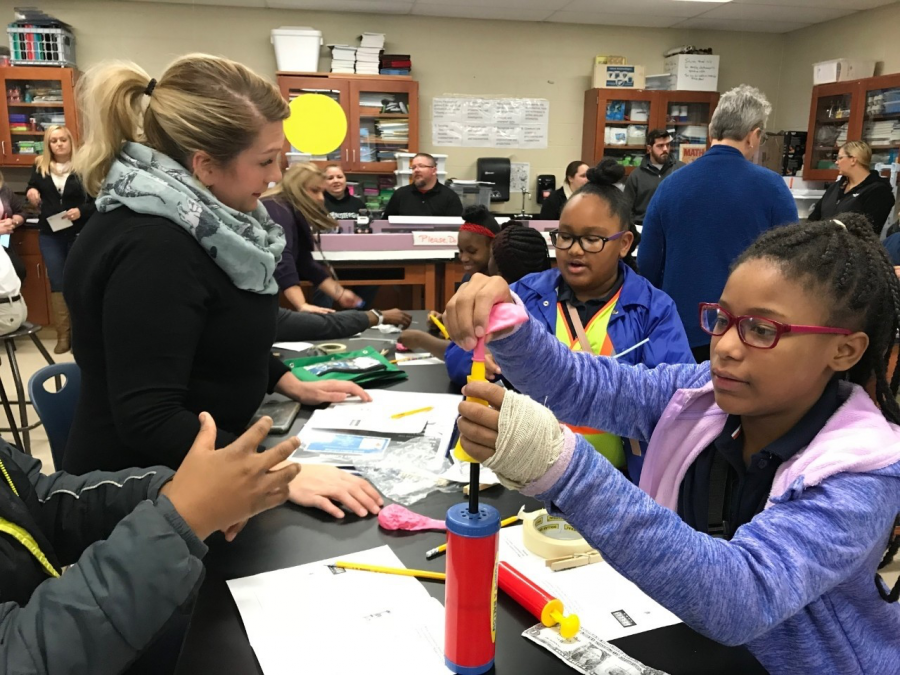CINSAM’s STEM Outreach Director Ella Bowling and school students.
Breathing life into classrooms with STEM
December 5, 2019
Termites. Toads. Mealworms. Madagascar hissing cockroaches. These animals are considered pests in a home, but in P-12 science classes across Kentucky and Ohio, they are essential teaching tools for NKU’s Next Generation STEM Classroom Project.
The university’s Center for Integrative Natural Science and Mathematics (CINSAM) has been visiting school districts to promote better STEM teaching practices since 2013. According to CINSAM director Madhura Kulkarni, the project is a professional development exercise for P-12 science teachers to learn how to better engage students and meet the national standards of STEM education.
The Next Generation STEM Classroom Project (ngSC) is divided into three segments: pre-cap, fishbowl and recap.
Kulkarni said the pre-cap portion of the project has just been implemented this year. Prior to engaging the students in the classroom, the CINSAM Outreach Team meets with the science teachers of the school district to inform them on what aspects to pay close attention to and equips them with an observation checklist.
According to Kulkarni, the team then follows the teachers into a classroom of their own students for the fishbowl section. The team performs lesson plans with students while the teachers observe the lesson model silently.
“While our teachers teach the lesson, [the school teachers] can observe the students—how they’re reacting and how they’re engaged,” Kulkarni said.
After the class, the team regroups with the teachers to go over how the lesson was successful in the recap segment.
Kulkarni said CINSAM was motivated to create this project when the Next Generation Science Standards were first introduced nationally to U.S. schools in 2010.
According to CINSAM’s STEM Outreach Director Ella Bowling, teachers were expected to revise their entire teaching strategies and lesson plans to fit the new standards.
“No longer could we do the cookbook labs where a kid gets a worksheet and they have to follow the instructions and fill out the data tables,” Bowling said. “Now we were really pushing more of the student-driven instruction in the classroom.”
Bowling was a middle school science teacher for 11 years before she was hired by CINSAM for their Outreach Team in late 2013. Since then, Bowling has been visiting school districts in Ohio and Kentucky with new lesson plans designed to reach the national requirements while also breathing new life into the classroom.
She described using termites and ink pens in a fourth grade classroom to teach students about pheromones. In another activity, she used cockroaches to teach speed and velocity.
“Our project is very unique in that we actually model lessons in a live classroom with real students,” Bowling said.
In other professional development programs, Bowling said teachers are usually given a slideshow presentation and test the labs out on one another in an isolated environment. When the teachers take those activities into the classroom, they become disappointed when the lesson doesn’t translate well to the students.
“I think the best part [of this project] is being able to deliver really high-quality resources to teachers because I know firsthand the struggle that’s out there to really get good lessons and activities that work in the classroom,” Bowling said.
For ngSC, Bowling said she spends months crafting new lesson plans each year for the schools as the needs of science teachers continually evolve. Before introducing the lessons in ngSC, Bowling tests the student response in classrooms of other teacher associates.
“Before we even roll out the labs, [practicing in another classroom] allows us to really work out the kinks and make sure that we’re delivering a high-quality product,” Bowling said.
It’s a high-quality product that is also delivering high-quality results, according to researcher Patricia Bills from Oakland University.
Bills has been leading research on ngSC since 2013 while she was a former faculty member at NKU. She continues to work closely with CINSAM to monitor the long-term effects of ngSC on science classes.
According to Bills, she collects survey data and conducts personal interviews with teachers throughout the process. Bills said her results have found a straight correspondence of teachers finding the strategies easy to apply in their own classrooms.
“In other words, it’s working,” Bills said.
According to Bills, teachers are more likely to try ngSC’s teaching strategies and lesson plans because they are able to witness firsthand how the models help students learn.
Since the new standards have been in use since 2013, Kulkarni said ngSC is now focusing more on how to engage all types of students in STEM learning.
“Every student walks in with their own background knowledge, with their own strengths, and with their own ways of doing things,” Kulkarni said. “So how do you teach science, especially in a way that all students can really engage with?”
Bills and Kulkarni have presented ngSC at national conferences, such as the National Association of Research on Science Teaching.
“To my knowledge, there is nothing like ngSC in this country,” Bills said.
During the first year of ngSC, Kulkarni said CINSAM was servicing two districts in Northern Kentucky. In 2019, ngSC is involved with nearly 30 school districts in Northern Kentucky, Central and Western Kentucky and Southwestern Ohio.
Kulkarni said she is hopeful that CINSAM’s program will be able to reach even more STEM educators on a national scale.

